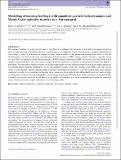Files in this item
Modelling of ionizing feedback with smoothed particle hydrodynamics and Monte Carlo radiative transfer on a Voronoi grid
Item metadata
| dc.contributor.author | Petkova, Maya A | |
| dc.contributor.author | Vandenbroucke, Bert | |
| dc.contributor.author | Bonnell, Ian A | |
| dc.contributor.author | Kruijssen, J M Diederik | |
| dc.date.accessioned | 2021-09-29T14:30:05Z | |
| dc.date.available | 2021-09-29T14:30:05Z | |
| dc.date.issued | 2021-10 | |
| dc.identifier | 276084640 | |
| dc.identifier | e36891ef-8631-498e-9bf5-f830674174a9 | |
| dc.identifier | 85115028819 | |
| dc.identifier | 000696261000063 | |
| dc.identifier.citation | Petkova , M A , Vandenbroucke , B , Bonnell , I A & Kruijssen , J M D 2021 , ' Modelling of ionizing feedback with smoothed particle hydrodynamics and Monte Carlo radiative transfer on a Voronoi grid ' , Monthly Notices of the Royal Astronomical Society , vol. 507 , no. 1 , pp. 858-878 . https://doi.org/10.1093/mnras/stab2178 | en |
| dc.identifier.issn | 0035-8711 | |
| dc.identifier.other | Jisc: 74c39f3d211b45a7837cd164e6177308 | |
| dc.identifier.other | ORCID: /0000-0001-7241-1704/work/100901594 | |
| dc.identifier.uri | https://hdl.handle.net/10023/24052 | |
| dc.description | MAP and IAB acknowledge funding from the European Research Council for the FP7 ERC advanced grant project ECOGAL. MAP and JMDK gratefully acknowledge funding from the European Research Council (ERC) under the European Union’s Horizon 2020 research and innovation programme via the ERC Starting Grant MUSTANG (grant agreement number 714907). JMDK gratefully acknowledges funding from the German Research Foundation (DFG) in the form of an Emmy Noether Research Group (grant number KR4801/1-1). BV acknowledges partial funding from the Science and Technology Facilities Council (STFC) grant ST/M001296/1 and currently receives financial support from the Belgian Science Policy Office (BELSPO) through the PRODEX project ‘SPICA-SKIRT: A far-infrared photometry and polarimetry simulation toolbox in preparation of the SPICA mission’ (C4000128500). Part of this work was performed using the DiRAC Data Intensive service at Leicester, operated by the University of Leicester IT Services, which forms part of the STFC DiRAC HPC Facility (www.dirac.ac.uk). The equipment was funded by BEIS capital funding via STFC capital grants ST/K000373/1 and ST/R002363/1 and STFC DiRAC Operations grant ST/R001014/1. | en |
| dc.description.abstract | The ionizing feedback of young massive stars is well known to influence the dynamics of the birth environment and hence plays an important role in regulating the star formation process in molecular clouds. For this reason, modern hydrodynamics codes adopt a variety of techniques accounting for these radiative effects. A key problem hampering these efforts is that the hydrodynamics are often solved using smoothed particle hydrodynamics (SPH), whereas radiative transfer is typically solved on a grid. Here we present a radiation-hydrodynamics (RHD) scheme combining the SPH code phantom and the Monte Carlo radiative transfer (MCRT) code cmacionize, using the particle distribution to construct a Voronoi grid on which the MCRT is performed. We demonstrate that the scheme successfully reproduces the well-studied problem of D-type H ii region expansion in a uniform density medium. Furthermore, we use this simulation setup to study the robustness of the RHD code with varying choice of grid structure, density mapping method, and mass and temporal resolution. To test the scheme under more realistic conditions, we apply it to a simulated star-forming cloud reminiscing those in the Central Molecular Zone of our Galaxy in order to estimate the amount of ionized material that a single source could create. We find that a stellar population of several $10^3~\rm {M_{\odot }}$ is needed to noticeably ionize the cloud. Based on our results, we formulate a set of recommendations to guide the numerical setup of future and more complex simulations of star forming clouds. | |
| dc.format.extent | 21 | |
| dc.format.extent | 5630663 | |
| dc.language.iso | eng | |
| dc.relation.ispartof | Monthly Notices of the Royal Astronomical Society | en |
| dc.subject | Radiation: dynamics | en |
| dc.subject | Methods: numerical | en |
| dc.subject | H II regions | en |
| dc.subject | Galaxy: centre | en |
| dc.subject | QB Astronomy | en |
| dc.subject | QC Physics | en |
| dc.subject | NDAS | en |
| dc.subject.lcc | QB | en |
| dc.subject.lcc | QC | en |
| dc.title | Modelling of ionizing feedback with smoothed particle hydrodynamics and Monte Carlo radiative transfer on a Voronoi grid | en |
| dc.type | Journal article | en |
| dc.contributor.sponsor | European Research Council | en |
| dc.contributor.sponsor | Science & Technology Facilities Council | en |
| dc.contributor.institution | University of St Andrews. School of Physics and Astronomy | en |
| dc.contributor.institution | University of St Andrews. Sir James Mackenzie Institute for Early Diagnosis | en |
| dc.identifier.doi | 10.1093/mnras/stab2178 | |
| dc.description.status | Peer reviewed | en |
| dc.identifier.grantnumber | en | |
| dc.identifier.grantnumber | ST/M001296/1 | en |
This item appears in the following Collection(s)
Items in the St Andrews Research Repository are protected by copyright, with all rights reserved, unless otherwise indicated.

